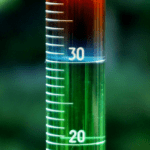Mixing Viscosities Calculator: To predict blend viscosity of two or more base oils or to predict mixing ratio of base oils to reach the desired viscosity. For best results, blend base fluids from a base stock slate or fluids from the same manufacturer. See API Base Oil Interchangeability Guidelines.
Mixing Viscosities: Oil Viscosity Calculators for the blend of 2-4 base oils.
Module #1: Oil Viscosity Calculator to predict blend (mixing) viscosity of two base oils.
To predict the mixing viscosity (blend) of two liquids or base oils:
1- Enter viscosity of the first base oil
2- Enter viscosity of the second base oil
3- Fill in the percentage (%) of the first oil in the blend.
3- Select the temperature for the viscosity measurements. Viscosity measurements must be at the same temperature for both oils.
4- Click Calculate button to predict the mixing viscosity of the two oil blends at the selected temperature.
Module #2: Calculator to predict mixing ratio to reach desired oil viscosity.
To get a percentage of each oil to reach a target viscosity by mixing or blending two base oils:
1- Fill viscosity of the first oil
2- Fill viscosity of the second oil.
3- Fill in the desired viscosity. Desired viscosity must be between the viscosity of first and second base oils.
4- Select the temperature for the viscosity measurements. Viscosity measurements must be at the same temperature for both oils
5- Click Calculate button to predict the mixing ratio of each base oil to reach the desired viscosity.
Module #3: Mixing viscosities calculator to blend or mix more than two base fluids.
1- Fill the viscosity of Base oil #1 and weight percent (Wt%) in the third (Wt%) column.
2- Fill in the viscosity of Base Oil #2 and weight percent (Wt%) in the next column.
3- Fill in the weight percent (Wt%) and Base oil #3 viscosity in the 3rd row. If you don’t want to include 3rd and 4th base oils, fill any value (>1) in the viscosity cell and zero (0) in the Wt%.
4- Repeat the same for Base Oil #4 by filling in the viscosity and Wt% of the Base oil.
5- Click Calculate to predict the mixing viscosity of the blend.
Please note: Leave the default value of “1” in the viscosity field if blending less than two liquids. Fill in zero 0 (or leave default “0”) in Wt % if not included in the blending calculations.
6- The Sum of Wt% must be 100.
Viscosity temperature is not required but must be the same for all base oils viscosities.
You can use this calculator to predict mixing viscosities of 2-4 base oils. Fill in zero (0) in the weight percent column (Wt%) if Base oil #3 and-or Base oil #4 are not part of the mixing viscosities.
Top Picks
Viscosity index (VI) calculator from Kinematic Viscosity (KV) at 40 °C and 100 °C according to ASTM D2270-10 and ISO 2909.
- Viscosity-temperature Extrapolation (ASTM D341)Standard Practice for Viscosity-Temperature Charts for Liquid Petroleum Products If you know the… Read more: Viscosity-temperature Extrapolation (ASTM D341)
- Dynamic Viscosity and Kinematic Viscosity CalculatorConversion between dynamic and kinematic viscosity Two Calculators are provided for conversion between… Read more: Dynamic Viscosity and Kinematic Viscosity Calculator
- Mixing Viscosity (Blending) CalculatorMixing Viscosities Calculator: To predict blend viscosity of two or more base oils… Read more: Mixing Viscosity (Blending) Calculator



Sir, if We have both Available Grades of Oils Viz 55 cst @ 40.0c & 430 cst @ 40.0c . Desired Blend is 68 & 100 Respectively . As a Third Component to improve Performance & desired Index of 105 – in Group -1 Oils how much %age of OCP VI improver of 1000cst Will be Required Per 100 Ltr With affordable cost . How much Index 01 kg of OCP Polymer improves in 85 VI base oil 100 Ltr base oil Quantity
Hi , I would like to get get the calculation for CALCLATOR # 3, in excel sheet. Thanks
Actually, you are both incorrect.
to take a SN150 base oil of 5.13cst@100c to 18cst, you would need 33% of a 1500cst@100c VI improver to reach 18cst@100c
Thanks for your input — I double-checked the numbers. To raise a 5.13 cSt base to 18 cSt @100°C requires an increase of 12.87 cSt. With typical VI improvers that works out to ≈13%–17% of improver, not 33%.
Also, treating a VI improver as if it were a 1500 cSt base oil and linearly averaging viscosities is not correct — VI improvers are polymers whose contribution is measured in small cSt per percent, not as a direct high-viscosity blend component. If you used a simple linear average with a “1500 cSt” component you’d actually get ≈0.86% required (solve 1500·x + 5.13·(1−x) = 18), so the 33% figure doesn’t match either approach.
If you were using different measurement temperatures (e.g. 40°C numbers) or a particular concentrate (with a given % active polymer), please share those details and we can recompute.
Dear Admin,
Can you provide formula for these CALCULATOR, especially for #3.
Thanks in advance admin
Animesh KV of VII at 100 is wrong. It should be aprox 1100 cSt
Dear team,
What’s the basis of % of base oils formulated to give the right consistency?
Is the % fixed?
For example, how do we know to formulate hydraulic oils 46 mineral, like how to know the exact % of base oils required to meet the VG.
Best regards,
It is easy, Just enter the base oils viscosity in the calculator:
For example:
Viscosity of SN500 base oil @ 40°C is: 90cSt
Viscosity of SN150 base @40°C is: 30cSt
Desired viscosity is: 46cSt at 40°C
Enter above data into Viscosity Calculator #2 and the result is:
SN500 40.93%
SN150 59.07%
Please note base oils viscosity can be different. Make sure to enter exact viscosity of the base oils.
Your lab results are wrong. Mixing SN150 (5.13 cSt) and SN500 (10.9 cSt) will produce <9cSt viscosity. Mixing 10% of high viscosity oil (220+190 cSt) into this, will not bring 18 cSt. You are trying to make 20W-50 oil I guess. We use 10-12% of polymeric thickener or viscosity index improver with viscosity of 1500 cSt to reach 18cSt.
You have to add 10-12% or more viscosity index improver with viscosity of 1500 cST or higher to reach 18 cST. Check your lab results.
Yes U r right, we were making 20w 50. Usually we used SN 150 & 10% VI improver polymer to Make liquid VI improver, and my boss told me that liquid VI improver vis @100 is approx 220 cst. And 190 cst is the additive viscosity. Based on this we made…
Oil 1 Vis @100: 5.13 with 23 %
Oil 2 Vis @100: 10.9 with 67%
Oil 3 Vis @100: 220 with 8%
Oil 4 Vis @100: 190 with 2%
Lab result was 18 cst @100.
Used Calculator 3# My input was
Oil 1 Vis @100: 5.13 with 23 %
Oil 2 Vis @100: 10.9 with 67%
Oil 3 Vis @100: 220 with 8%
Oil 4 Vis @100: 190 with 2%
As per calculator it was 10.9 cst @ 100. But practically it comes in laboratory 18 cst @100.
Please help me out
Great Calculation. Will be more helpful if I get the calculation for CALCLATOR # 3, in excel sheet. Thanks
Thanks for the comment, I will pass the request to my technical team.